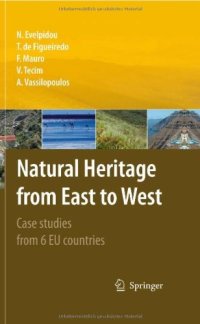
Ebook: Natural Heritage from East to West: Case studies from 6 EU countries
- Tags: Nature Conservation, Landscape/Regional and Urban Planning, Geology, Conservation Biology/Ecology
- Year: 2010
- Publisher: Springer-Verlag Berlin Heidelberg
- Edition: 1
- Language: English
- pdf
Cumulative global transformations, occurring daily, affect important aspects of our life. Characteristic cultural and natural heritage, including sites of priceless value, is under constant threat. There are growing pressures, of both natural and human origin, such as wars, con icts, natural or technological disasters and the effects of global climate change. These provoke the continuous degradation of many sites included in the World Heritage List. In consequence, immediate strategic measures must be taken. Natural heritage is our legacy from the past, that we inherited from our ancestors and pass on to future generations. It is vital to realize its value and protect it by all possible means, enforcing innovative and sustainable action plans that promote global international co-operation. This book aims to address speci c natural heritage sites in Europe, from West to East. The six countries of study interest are Portugal, Malta, Greece, Italy, Romania and Turkey. For each case, the corresponding current status is presented. This is accompanied by recommended action plans for protection and conservation, tra- ing initiatives that improve the public awareness of natural heritage issues and efforts to estimate the natural/environmental value of the sites. The book is the overall result of an interregional initiative aiming to promote convergence, provoke public interest and recommend action for radical changes in our attitude towards heritage conservation.
The publication is an initiative generated within the European Project Leondardo da Vinci Pilot Project "EduNatHer", Educational Strategies for the Promotion of Natural Heritage and was co-funded by the European community. The Leonardo da Vinci Pilot Project is one of the longest-running instruments supporting cooperation among educational organizations, scientists and researchers across Europe. The book is the result of cooperative work among academic and research institutes originating from six countries; Greece, Romania, Portugal, Italy Malta and Turkey, and its focus is to present natural landmarks and monuments from those countries. The main objective of the book is to construct a meaningful link between educational organizations, research institutes, public and private sectors involved in research, preservation and management of natural sites. Each country presents up to 15 natural sites of environmental or educational interest within a geographical zone spanning Europe from east to west.